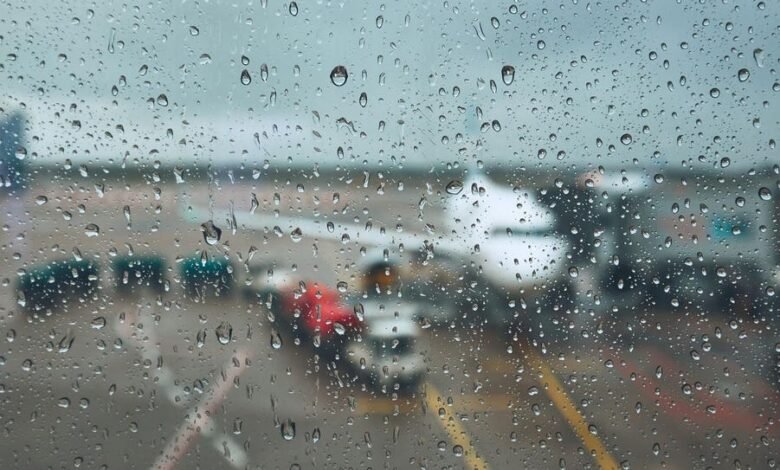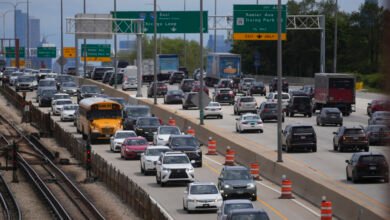Unbelievable! Over 4,300 Flights Delayed Amidst Severe Thunderstorms on Memorial Day Weekend – Your Travel Plans Could Be Next!

Memorial Day Travel Woes: A Deep Dive into the Impact of Severe Thunderstorms on Air Travel
Memorial Day weekend acts as a rite of passage for the summer travel season, marking the time when Americans hit the roads and skies in droves to kick off warm-weather adventures. However, this year, the joy of travel was significantly overshadowed by a wave of severe thunderstorms, which wreaked havoc at airports nationwide. With more than 4,300 flights delayed, travelers faced a myriad of frustrations that affected their holiday plans. Let’s explore the key factors contributing to these disruptions and the broader implications for summer travel.
The Size and Scale of the Disruptions
This year’s Memorial Day weekend saw a staggering number of flights delayed. Airlines were caught off-guard by severe thunderstorms, primarily affecting the East Coast and Midwest regions, leading to widespread travel chaos. According to the data from the Federal Aviation Administration (FAA), over 4,300 flights were held up, creating a domino effect that impacted both domestic and international travelers. In addition, the storms brought about heavy rainfall, lightning, and tornado warnings, further complicating travel logistics.
The FAA reported that New York and Chicago were among the worst-affected cities, with thousands of passengers stuck at airports. The intensity of the storms was notable, as certain areas experienced torrential downpours and wind gusts that reached dangerous levels—making it impossible for flights to depart or land safely.
How Thunderstorms Disrupt Air Travel
Severe weather can be particularly detrimental to air travel for several reasons. First and foremost, thunderstorms can create hazardous flying conditions. The presence of turbulence, lightning, and low visibility can make it unsafe for pilots to navigate their aircraft. In instances where thunderstorms are forecasted, airlines often preemptively delay or cancel flights to protect passenger safety. This proactive approach minimizes the chance of in-flight emergencies but also leads to travel frustrations.
Moreover, when one flight is delayed or canceled, it has a ripple effect across the airline’s entire schedule. Aircraft and crew become unavailable for subsequent flights, and soon a chain reaction of delays can unfold. Airports become crowded with passengers seeking information and assistance, leading to long lines and further delays.
Travel Preparedness: Tips for Navigating Storm-Impacted Travel
For travelers faced with delays due to severe weather, being prepared is essential. Here are some key strategies for managing your trip during turbulent weather conditions:
- Stay Informed: Regularly check weather updates and your airline’s website or app for real-time status on your flight. Being informed allows you to make timely decisions about your travel.
- Build in Extra Time: If possible, consider booking flights for earlier in the day to reduce the risk of delays caused by weather systems building throughout the day.
- Flexible Booking: Choose airlines that offer flexible booking terms, allowing you to change your flight with little to no penalty in case of significant delays or cancellations.
- Pack Essentials: Keep necessary items in your carry-on, including medications, snacks, chargers, and any important documents. If you face unexpected delays, having these essentials accessible will enhance your comfort.
- Stay Calm and Patient: With thousands of other travelers facing similar disruptions, patience is critical. Keep a positive attitude and utilize this time to connect with fellow travelers or engage in activities like reading or listening to music.
Airlines’ Response to Disruption
In light of widespread disruptions, airlines are adjusting their operation strategies and policies. Major carriers emphasize their commitment to keeping passengers updated during crises, often through various communication channels such as text alerts, social media updates, and mobile apps. They are also increasing staffing levels at key airports to handle customer inquiries and manage rebookings more efficiently.
Despite efforts to improve communication, frustrations remain high among travelers. Many passengers express disappointment over inconsistent information regarding their flight status—the need for real-time updates has never been greater. Airlines are striving to balance efficiency with safety during severe weather, making modifications to scheduling as weather patterns develop.
The Broader Impact on Summer Travel
As we move further into the summer, the challenges witnessed during Memorial Day weekend may set a precedent for upcoming travel experiences. Travelers should expect that weather-related disruptions may be more frequent during peak summer travel times. Factors such as increased vacationing families, the lingering effects of post-pandemic travel surges, and unpredictable weather patterns may exacerbate delays.
For many, the combination of all these stressors can make air travel quite challenging. As the summer months approach, it’s crucial for both airlines and travelers to prepare for what could be a busy—and potentially disrupted—travel season. Here are a few key takeaways to consider:
- Maximize Awareness: Stay informed about weather patterns that typically affect flights during the summer months, such as thunderstorms and hurricanes.
- Engage with Airlines: Understand your airline’s policies regarding delays and cancellations so that you know your rights and available remedies.
- Consider Alternate Transportation: In some instances, you may find it beneficial to explore alternate modes of transportation, such as trains or buses, particularly if you are traveling short distances.
In Conclusion
The severe thunderstorms experienced over the Memorial Day weekend serve as a stark reminder of how unpredictable weather can affect travel plans. Millions of people eagerly awaited their summer getaways, only to find their plans disrupted by nature’s fury. However, by remaining informed, adapting to changing conditions, and preparing for potential travel woes, travelers can better manage future trips and navigate whatever challenges come their way.
Summary of Key Findings
- Over 4,300 flights were delayed during Memorial Day weekend due to severe thunderstorms, primarily affecting major airports in New York and Chicago.
- Thunderstorms can lead to dangerous flying conditions, prompting airlines to preemptively delay or cancel flights.
- Travelers can navigate storm-impacted trips by staying informed, building in extra time, choosing flexible bookings, packing essentials, and maintaining a calm demeanor.
- Airlines are increasing communication and support for customers to manage disruptions effectively.
- As summer travel approaches, travelers should remain aware of weather patterns and consider alternative transportation methods when necessary.





